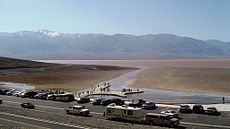Sink (geography)

Death Valley, Spring 2005: ephemeral Lake Badwater in the flooded Badwater Basin
This article may be too technical for most readers to understand. Please help improve it to make it understandable to non-experts, without removing the technical details. (November 2017) (Learn how and when to remove this template message) |
A geographic sink is a depression within an endorheic basin where water collects with no visible outlet. Instead of discharging, the collected water is lost due to evaporation and/or penetration (water sinking underground, e.g., to become groundwater in an aquifer). If the sink has karstic terrain, water will sink at a higher rate than the surface evaporation, and conversely if the lakebed or sink bed has a layer of soil that is largely impervious to water (hardpan), evaporation will predominate. Since dry lakes in sinks with hardpan have little penetration, they require more severe aridity/heat to eliminate collected water at a comparable rate as for a similar sink with appreciable penetration.
Depending on losses, precipitation, and inflow (e.g., a spring, a tributary, or flooding); the temporal result of a lake in a sink may be a persistent lake, an intermittent lake, a playa lake (temporarily covered with water), or an ephemeral lake.
List of geographic sinks
Mediterranean Sink during the Messinian Event
Red Sea when blocked off by the Perim volcano- Africa: Afar Depression
- USA: Carson Sink
- USA: Humboldt Sink
- USA: Quinn River Sink
- USA: Salton Sink
See also
Endorheic basin – Closed drainage basin that allows no outflow
Sinkhole – Depression or hole in the ground caused by collapse of the surface into an existing void space
References
This article relating to topography is a stub. You can help Wikipedia by expanding it. |
This hydrology article is a stub. You can help Wikipedia by expanding it. |